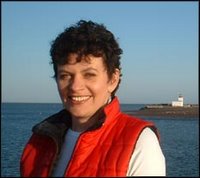 As I noted it my last blog post it's truly been an amazing year for whale watching in Bay of Fundy. Whale watching is a great outdoor adventure activity for all ages. Here in Bay of Fundy, we've got some strict guidelines for our whale watch companies about what they can and cannot do around whales. Good thing for telephoto lenses then!
As I noted it my last blog post it's truly been an amazing year for whale watching in Bay of Fundy. Whale watching is a great outdoor adventure activity for all ages. Here in Bay of Fundy, we've got some strict guidelines for our whale watch companies about what they can and cannot do around whales. Good thing for telephoto lenses then!
The folks at Quoddy Link Marine whale watching in St Andrews, New Brunswick, sent along this amazing photo and note yesterday:
Here's a picture taken by one of our Marine Biologist guides: we were so blown away by this! It is a lunge-feeding Finback whale, and, if you look closely, you can see 2 seagulls in its mouth. We certainly hope the seagulls survived (the whale would not be able to eat them as Finbacks are baleen whales and you can see the baleen hanging from the whale’s upper jaw). See more photos and read more about this sighting on our blog.
Here's a bit more info about baleen from Wikipedia: baleen is a filtering structure in the mouth of most whales, which they use to feed by sieving small animals from large mouthfuls of seawater. Instead of teeth, these whales have rows of baleen plates in the upper jaw–flat, flexible plates with frayed edges, arranged in two parallel rows, looking like combs with thick hair at the end of each comb tooth. Baleen is not in fact composed of bone, but of the protein keratin, the same substance as hair, horn, scales, claws and nails. Baleen whales use these combs for filter feeding.
Monday, August 02, 2010
Amazing whale watch photo!
Subscribe to:
Post Comments (Atom)






3 comments:
We went whale watching with Quoddy last year ... we were surrounded by 30-40 right whales. It was truly amazing. The guides were losing their minds.
We went whale watching with Quoddy last year, and saw 30-40 right whales. It was a truly amazing experience.
it's Danielle with Quoddy Link, I was on all of those right whale trips of 2009 and yes, Jolinne and I were losing our minds, it was such a privilege.
The photo here was taken by Nick, lunge feeding fin whales were a common site during the 2010 season.
Post a Comment